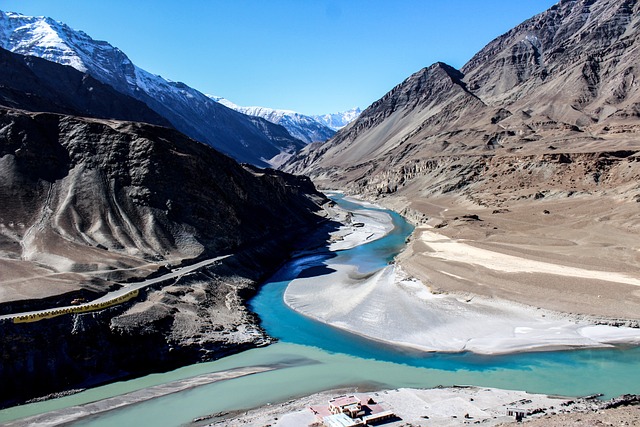Indus River System- Length, Tributaries and Importance
The Indus River System comprises of the Indus River in Pakistan as well as a number of smaller tributaries originating from it. Together, they form the Indus River System. It is one of the longest rivers in the world with a length of 2000 miles (3200 km).
Tributaries and Features of the Indus River:
It begins near Lake Mapam in Tibet– the autonomous region of China, flows into the disputed Kashmir region from where it enters Ladakh in India. From there it is joined by its first major tributary: the Zaskar River. From there it continues and enters Azad Jammu Kashmir and is joined by another tributary: Shyok River. It continues on throughout Kohistan and KPK in Pakistan where it is fed by large glaciers on Karakoram Range and Nanga Parbat itself. Other streams incoming from Gilgit and Shigar also join the Indus.
Other tributaries part of the Indus River System include: Gilgit River, Astor River, it also flows into the Swat river from where it emerges into the reservoir of Tarbela Dam. Kabul River joins the Indus near Attock and ultimately enters the Punjab plain. Onwards it becomes huge as it is fed by the rivers of Punjab- Jhelum, Sutlej, Ravi, Chenab and Beas. After this the Indus eventually forms a delta and joins the Arabian Sea in Karachi.
You might also be interested in: Pakistan’s Living Indus Initiative And Its Importance
Problems Faced By The Indus River:
- Pollution: The Indus River is one of the largest river systems in the world with a flow that exceeds that of the river Nile and three times that of Tigris and Euphrates. However, it is unfortunate that it is also one of the world’s most polluted rivers in the world with major plastic, pesticides and agro-chemical pollution in the form of phosphates and nitrates coming from settlements dotted across its length. Improper agricultural practices contribute majorly to the pollution of the Indus and has lead to further dire consequences as will be mentioned ahead.
- Climate Change: Predictive reports mention that global warming will greatly alter the peak volumes and flow of the Indus River due to irregular rainfall pattern in the Monsoon season. Climate change makes Indus River particularly vulnerable as it could lead it to dry up at times and otherwise cause flooding. You might also want to read: Climate Change and Its Impact on Pakistan.
- Siltation: As the Indus river flows from Tibet and reaches Punjab, its flow slows down which gives time for the accumulated silt and particles to accumulate in the flat plains of Punjab. The increased sediment load as well as the ongoing pollution from agricultural activities further aggravate the siltation problem in the river and make the water nearly unusable for drinking and unlivable for the aquatic organisms.
- Loss of Delta: The Indus Delta used to be one of the most fertile lands as the river emptied into the Arabian sea, however, due to the mismanagement of the water and pollution, there has been a decline in the deposition in the region which has lead to the loss of the Indus Delta. The river, as a result has shrunk by 92%- now only about 250 sq km. in a sharp contrast to 13000 sq km. This is greatly detrimental to the humans reliant on it as well as the ecology of the region.
- Illegal Exaction of Land: The illegal authorization of land use in and around the Indus delta region is the main cause of the degradation of the Indus Valley. This has caused increased problems of industrialization, urbanization and mass migration that has burdened the Indus river. Check out: Urbanization- Effects, Causes and Solutions Urbanization affects Microclimate of Abbottabad, Pakistan
- Floods: The rivers joining the Indus as it enters Punjab widens the river by several miles which often lead to flood and therefore catchments need to be made. However, the major flow of the Indus River is made up by the meltwater coming from snow and icecaps of glaciers in the Himalayan and Karakoram range. Due to climate change and melting of glaciers, this has been aggravated and there is a higher risk of flooding than ever before. The devastating floods of 2010 also happened because of the Indus River flow that impacted 14 million people in Pakistan. Related: How to Reduce Severity of Disastrous Impacts of Floods
- Degradation of Ecosystems: the excessive pollution and siltation of the river leads to major problems of decline in biodiversity, silt covers spawning sites for many endemic fish, diminished food sources for benthic organisms and also impairs aquatic organisms in the river who feed visually. Check out: Ecosystem Zones and Climatic Biomes of Pakistan.
- Endangered Species: The Indus River Dolphin also known as ‘Bhulan’, the initial reason for their decline was the construction of dams and barrages as a mitigatory measure for floods. However, in the process it resulted in habitat degradation and fragmentation of the dolphins as well as prevented them from migration. Now, extreme pollution and poaching by overpopulated settlements have further caused their decline. For more information: 12 Vulnerable and Endangered Animal Species of Pakistan.
You might also be interested in: Current Environmental Issues In Pakistan – List With Detail.
CONCLUSION:
The majority of the problems faced by the Indus River is due to the mismanagement of the water by Pakistan Governments since years. The degradation of Indus is directly linked to the poor management, lack of care and conservation for the river and its ecosystem, poor economy, ignoring the ever increasing industrialization and illegal land acquirement and development taking place along its banks. This among a dozen other reasons have lead to a devastating consequence of the once rich and fertile river.
The River Indus is dying and it is becoming increasingly important that its concerns be given proper attention and be addressed. Since it sustains millions along its length across Pakistan it is ever crucial that policies are made and implemented to prevent further problems for the people of Pakistan on top of climate change induced events.
You may also like: Impact of Climate Change on Water Resources of Pakistan
I hope you all liked this post! Please comment below if you have any suggestions, comments, or feedback! We at #envpk love hearing from our readers! Thanks!




